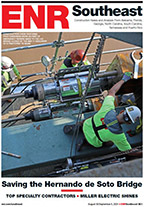The value of new construction starts retreated 6% in January to a seasonally adjusted annual rate of $423.4 billion, according to McGraw-Hill Construction, a division of The McGraw-Hill Cos.
The decline came as the result of a pullback for nonresidential building after a strong December, combined with a loss of momentum for residential building. At the same time, the nonbuilding construction sector showed further growth in January on top of its elevated December pace, aided by several large public works projects. On an unadjusted basis, total construction starts in January were reported at $28.4 billion, down 4% from the same month a year ago.
The January statistics lowered the Dodge Index to 90 (2000 = 100), compared to December’s reading of 95. Over the course of 2010, the Dodge Index fluctuated within the range of 80 to 96, with the average for the year coming in at 88.
“The construction start statistics continue to move in an up-and-down pattern, showing that overall activity has stabilized in a broad sense but has not yet gained sufficient traction for renewed expansion to take hold,” said Robert A. Murray, vice president of economic affairs for McGraw-Hill Construction. “Over the past two years, public works construction has held up fairly well, and healthy activity was reported for this sector in January. However, public works construction is likely to slip in coming months, given waning support from the federal stimulus act and mounting fiscal stress for federal, state and local governments.
“This fiscal stress will also have a dampening impact on various institutional building types, such as school construction. For total construction starts to register growth in 2011, it will require more upward movement from housing, after the tenuous gains witnessed during 2010.
“It will also require some upward movement or at least stability for commercial building, after last year’s extremely depressed activity. One early positive sign for commercial building is that vacancy rates appear to have topped off during 2010 and are now receding slightly.”
Nonresidential Building The nonresidential market in January dropped 13% to $138.3 billion (annual rate), following December’s strong 27% gain. Health-care facilities in December were lifted by the start of six massive hospital projects, and January showed this category retreating 46% from its exceptional December amount. The health-care category in January was still 7% above its monthly average for 2010 as a whole and included the start of two large hospital projects located in San Leandro, Calif., ($575 million) and Oakland ($244 million). Transportation terminal work in January was also down sharply, falling 75%, compared to a robust December that included the start of a $450-million airport terminal project at Love Field in Dallas. The largest transportation terminal project in January was an $86-million airport terminal expansion in Myrtle Beach, S.C. Other institutional categories showing decreased contracting in January were public buildings, down 2%; churches, down 4%; and amusement-related work, down 29%. Educational buildings, the largest nonresidential building category, held steady in January. Support came from groundbreaking for two large high schools located in Texas ($112 million) and South Carolina ($75 million), plus the start of a $100-million medical school building in New Jersey and a $71- million art museum in Florida.
The commercial structure types showed a mixed performance in January. Stores and warehouses slipped further, with January declines of 2% and 4%, respectively. Office construction in January registered a 5% gain, helped by groundbreaking for four projects valued each in excess of $100 million. These included two corporate office buildings, located in Boston ($252 million) and Beachwood, Ohio ($120 million), a federal government office building in Clarksburg, W.V. ($130 million), and a data center in Boydton, Va. ($125 million). The hotel category in January increased 23%, lifted by the start of a $295-million convention center hotel in Washington, D.C. The manufacturing plant category also showed growth in January, climbing 180% from a weak December, with the boost coming from a $300-million upgrade to an automotive assembly plant in Louisville, Ky.
Residential Building At $118.8 billion (annual rate), residential building dropped 7% in January after showing modest improvement during the previous five months. Single-family housing held steady in January, as the result of varied behavior by geography, with growth in the South Central (up 6%) and the South Atlantic (up 5%) offsetting declines in the West (down 1%), the Midwest (down 1%), and the Northeast (down 20%).
The U.S. residential total in January was pulled down by 35% decline for multifamily housing, which retreated after the gains witnessed at the end of 2010. The largest multifamily projects that reached groundbreaking in January were a $32-million apartment building in Dallas, a $31-million apartment building in Tysons Corner, Va., and a $28-million apartment building renovation project in St. Louis.
Nonbuilding Construction The nonresidential sector in January advanced 2% to $166.3 billion (annual rate). Highway and bridge construction soared 42%, reflecting the lift coming from $1.5 billion for the start of work to add new lanes to the LBJ Freeway in Dallas. Other large highway and bridge projects reported as January starts included $140 million for a freeway-widening project in Placentia, Calif., and $114 million for work on the New Jersey Turnpike in Hamilton, N.J. Another substantial gain in January was posted by sewer construction, rising 44% with the boost coming from $199 million for the Euclid Creek Storage Tunnel project in Cleveland to reduce combined sewer overflows.
River/harbor development in January climbed 35%, aided by $250 million for work related to ongoing hurricane protection efforts in New Orleans, and the miscellaneous public works category (sitework and mass transit) grew 29%. Water supply construction was the one public works category in January to register a decline, sliding 38% after December’s 27% gain. As for electric utilities, January showed a reduced volume of construction starts relative to an exceptionally strong December, as contracting fell 41%. January’s level of electric utility construction was still strong by recent standards, up 56% compared to the average monthly pace during 2010. The large electric power plant projects reported as January starts included two massive solar power facilities located in Blythe, Calif. ($2.5 billion) and Ivanpah, Calif. ($505 million).
The 4% decline for total construction on an unadjusted basis in January 2011 relative to January 2010 was due to this performance by major sector: nonresidential building, down 24%; residential building, down 13%; and nonbuilding construction, up 30%.
The shortfall for nonresidential building reflected in part the inclusion of the huge $3-billion transit hub in lower Manhattan as a January 2010 start. If this project is excluded from the January 2010 statistics, nonresidential building in January 2011 would be flat relative to last year, and total construction would be up 6%.
By region, total construction for January 2011 compared to January 2010 revealed decreased activity in the Northeast, down 44%; and the South Atlantic, down 28%. Total construction gains on a year-over-year basis were reported for the Midwest, up 1%; the South Central, up 21%; and the West, up 37%.
Additional perspective can be obtained by looking at twelve-month moving totals, in this case the 12 months ending January 2011 versus the 12 months ending January 2010, which lessens the volatility present in one-month comparisons. For the 12 months ending January 2011, total construction was down 2%, due to this pattern by sector—nonresidential building, down 10%; residential building, up 5%; and nonbuilding construction, up 3%. By region, the 12 months ending January 2011 showed the following behavior for total construction compared to the prior 12 months: the South Atlantic, down 14%; the Northeast, down 4%; the Midwest, unchanged; the South Central, up 1%; and the West, up 8%.



Post a comment to this article
Report Abusive Comment